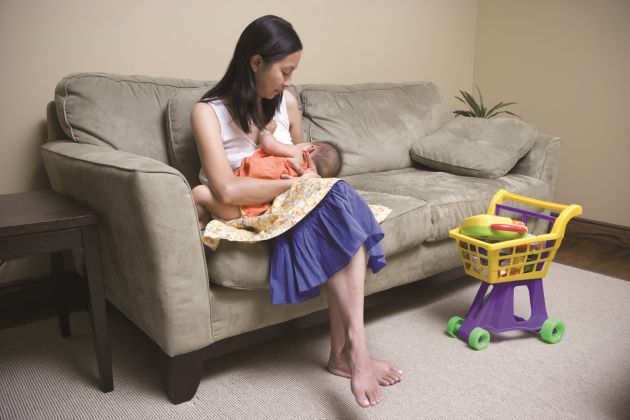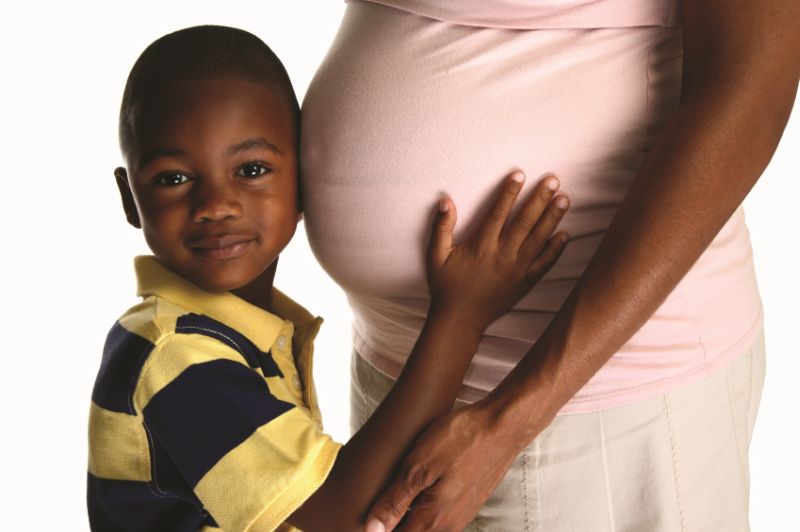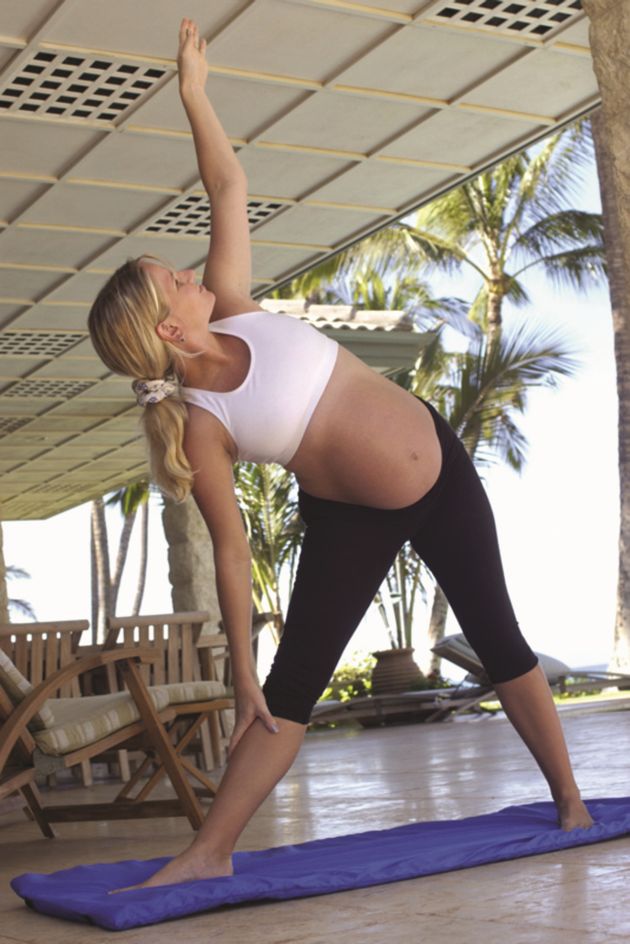Prenatal
2nd
TRIMESTER
Weeks 13-27
Prenatal – 2nd Trimester – Weeks 13-27
Worry and Excitement about Pregnancy Is Normal
 The more you do to get ready for your baby now, the less overwhelming it will be after they are born.
The more you do to get ready for your baby now, the less overwhelming it will be after they are born.
It is common in the second trimester for future moms to feel uncomfortable. The baby has grown so much that there’s not much room left for mom’s own organs. This may cause indigestion, vomiting, cramps, backaches, swollen feet, constipation, and trouble sleeping. Future dads often feel these sympathetic discomforts, too!
Baby’s Prenatal Development in the Second Trimester
Prenatal Month 4
- Baby is 4 to 5 inches long
- Weighs 3 to 5 ounces, which is about the same as a small banana
- Baby is covered in soft down-like hair
- Heartbeat is strong
- Stomach and rest of digestive system are growing
- Eyes, ears, nose, and mouth look normal
- Eyebrows and hair are growing
- Future mom’s average weight gain is 3-4 pounds per month
Prenatal Month 5
- Baby is about 8 inches long
- Weighs 1 pound
- Baby is strong enough for Mom to feel a kick
- Heart, lungs, and digestive system are growing
- Bones are forming and fingernails are growing
- Future mom’s average weight gain is 3-4 pounds per month
Prenatal Month 6
- Baby grows a lot this month and can be anywhere from 9-15 inches long
- Weighs 1½ to 2 pounds
- Can open their eyes and suck their thumb
- Baby can have hiccups
- Brain is growing fast
- Eyelashes and sex organs have formed
- Future mom’s average weight gain is 3-4 pounds per month
Your Second Trimester Prenatal Visits!
Your health care provider will track your baby’s growth, listen to your baby’s heartbeat, and assess fetal movement. You might be also offered various prenatal tests: genetic blood test to screen for genetic or chromosomal conditions, fetal ultrasound, blood tests for iron level and screen for blood glucose, and urine tests. Don’t forget to check with your dentist on your oral health.
Partners Play a Major Role in Pregnancy
It is common for partners to feel nervous or left out during pregnancy. Both parents are preparing for a major new life role and added responsibilities — but during the pregnancy, the focus is on the mom-to-be. Later on, the focus is on the new baby.
You may feel your partner’s focus on her changing body as a rejection of you. Right now, your partner really needs you. Pregnant women may feel insecure and vulnerable, making it a perfect time for a partner to be supportive and loving.
It’s important for couples to share their feelings with each other and for partners to involve themselves as much as possible. This will make for greater family closeness, even before the baby comes.
Manage Stress by Asking for Help and Talking To Others
Changing hormone levels can cause future moms to be irritable, and have mood swings and crying spells. Women may feel frustrated because their growing belly is uncomfortable. They may have trouble concentrating, remembering events or appointments, and feel as if they don’t know if they are coming or going. Here are some ways to deal with these feelings:
- Manage stress by cutting down on household chores. You might want to ask friends or relatives to help around the house, especially with baby chores such as getting the nursery together or reorganizing rooms.
- Do something for yourself. Pamper yourself by getting a new haircut or sign up for a prenatal yoga class. You need to stay in high spirits during your pregnancy, so remember to do something special just for yourself.
- Talk about it. If you feel overwhelmed or stressed, talk with your partner about your thoughts and feelings. By talking, you will find ways to lessen your stress. Talking with a professional counselor might also help.
Thinking About Breastfeeding

Breastfeeding is the best form of nutrition for your baby. Providing your milk for your baby immediately after giving birth is the foundation of your baby’s strong immune system, builds a strong relationship with your baby, and can be a source of happiness for you and your family. Formula is prepared from cow’s milk and should be used if needed. Whether you choose breast or bottle, a close bond between parents and baby can develop if you hold and cuddle your baby during feeding. Your baby can thrive whichever method you use. The American Academy of Pediatrics highly recommend exclusive breastfeeding (without any supplementation) for the first six months and continuation of breastfeeding with introducing complementary food until 12 months.
Benefits for the Baby
- Human milk is made for human babies and has the needed nutrients in the proper amounts
- Protects baby against infections, allergies, diarrhea
- Easily digested, few digestive upsets
- Convenient, always ready with no bottles to fool with
- No storage or special preparation needed
- Improves child’s brain development
- Babies drink only what they need, no overeating
- Protect your baby from the Sudden Unexpected Infant Death Syndrome (SUIDS)
- Provide protection against childhood overweight and obesity
Benefits for the Mother
- Decreased postpartum bleeding
- Decreased menstrual blood loss and increased child spacing (lactation amenorrhea)
- Earlier return to pre-pregnancy weight (help you lose weight)
- Decreased risk of breast and ovarian cancers
- Protection against cardiovascular and metabolic diseases
Economic Benefits
- Decreased healthcare costs (fewer clinic visits, fewer prescription meds for sick infants)
- Decreased costs associated with purchasing formula (~$1500 per year). If 90% of US mothers would comply with the recommendation to breastfeed exclusively for 6 months, there would be a savings of $13 billion per year.
Environmental Benefits
- Decreased pollution or waste associated with formula (manufacturing, packaging, disposal of containers, etc.)
Resources:
- Hospitals often offer breastfeeding classes, support groups, and consults. Check with your hospital before discharge and ask if they have support group.
- La Leche League is a national group that promotes breastfeeding and assists women who want to breast feed their babies. Ask in your local community about LLLI support.
- WIC (Women, Infants, and Children) is a supplemental food assistance program for pregnant women and women with babies and young children until 5 years. WIC offices provide prenatal breastfeeding classes and lactation support after giving birth.
- For information on women’s health issues (breastfeeding, menstrual cycles, medication while breastfeeding, domestic violence assistance, and more), call the OWH HELPLINE: 800-994-9662, 9 a.m. – 6 p.m. ET, Monday-Friday
- For more general information, the CDC has a parent portal.
Prepare Brothers and Sisters for the New Baby
If you have other children, prepare them for the new baby. A new baby may be a big change for other children in your family. To deal with this change:
- Talk to your children about what it will be like once the new baby arrives.
- Tell your children about your pregnancy by using books and pictures about how babies grow. You can also show them pictures and videos from when they were first born and tell them what they were like as new babies.
- If you have friends with new babies, it might be a good idea to visit them.
- Have your children practice holding a baby using a doll.
- Think of something fun your children can help you prepare for — like picking out a coming home outfit for the baby.
Children’s Books for New Big Brothers and Sisters
- The Berenstain Bears’ New Baby (Stan and Jan Berenstain)
- Peter’s Chair (Ezra Jack Keats)
- The New Baby (Mercer Mayer)
- The New Small Person (Lauren Child)
- Tell your children often that you love them.
- Allow them to help with the baby’s care — such as bathing, dressing, and feeding.
- Make special one-on-one time with your older children when each of them can express their feelings and thoughts to you. Your older children still need time for themselves and attention from you.
- Have some big brother or big sister gifts for your older children to make them feel special and needed.

Find Quality Child Care before Your Baby Is Born
If you will be using childcare for your baby, find a high-quality child care provider. Finding childcare now will be less stressful than trying to decide after your baby is born. Some programs have waiting lists. It helps to get your name on the list as early as possible.
A quality childcare center is a safe and nurturing place with enough qualified staff to care for the children in their center. Child Care Aware provides more information at www.childcareaware.org.
To find a quality childcare provider:
- Ask for recommendations. Ask friends and family members about childcare providers in homes or day care centers.
- Visit each location. Stay at least an hour or more and pay close attention to what’s going on. Do the children seem happy and active? Do the teachers pay attention to the children? Is it clean and inviting? Bring a friend along if you want another opinion.
- Ask questions. How many children is each adult caring for? How many children are in each group? Are you able to visit any time you like? What is their policy for sick children?
Choose. Consider all the pros and cons of each location. Think about costs, hours, location, and quality. Stay involved with your childcare center by visiting often, asking questions, and meeting with your child’s caregiver. Ask child care providers questions. Here are questions parents of babies should be asking.
Do the caregivers:
- Greet each parent and baby warmly; help baby separate by talking about parent leaving; encourage parents to spend time with baby and say good-bye before leaving?
- Frequently talk with each baby about what the baby is doing and listen and respond when babies “talk” to them?
- Interact warmly with babies during playtime and play with babies as babies play with toys?
- Hold and pat babies?
- Use pleasant voices, smile frequently, and help babies who are hurt or upset?
Are there enough caregivers present to meet each baby’s needs with little crying or waiting?
- There should be at least one caregiver for every 3-4 babies. There should be no more than 9 babies in a group with several caregivers.
- Does at least one of those caregivers stay with this group of babies for at least a year?
- Do caregivers have a certificate or degree in child development, early childhood education, or infant care (CDA,AA, BA/BS)?
Ask about care routines:
- Is the diapering area cleaned and disinfected after each use?
- Are different sinks used for food preparation and diapering cleanup?
- Does the feeding area look clean and sanitary?
- Do caregivers place babies on their backs to sleep? How are the youngest babies, who can’t turn over, placed in their cribs?
- Are there individual cribs for each baby present with firm, tight fitting mattresses?
Ask about the setting:
- Does the center support breastfeeding?
- Are there some soft rugs and other soft areas where children can play with supervision?
- Do babies who are not crawling or walking have a variety of safe places to play — including open floor space?
- Are there toys and equipment to encourage safe crawling, walking, climbing, pushing, pulling, and ball play? Will furniture and toys not tip over when babies are trying to pull themselves up?
- Are there low, open shelves where babies can get safe toys?
- Are toys and equipment in good repair with no sharp edges, splinters, or loose small parts?
- Are there many kinds of toys and activities for babies — like books, dolls, blocks, rattles, tubs to fill and pour out, and toys to push or pull?
- Are vinyl or hard page books available for babies to get on their own?
- Are there comfortable places where adults — including nursing mothers — can sit and hold babies?
- Are detergents, cleansers, medicines or other dangerous items locked up?
- Are parents asked to evaluate the program at least once a year?
What Will Your Baby Be Like?
- What will the baby look like?
- Will they be healthy?
- Will you love them right away?
- Will they love you?
Share your thoughts and concerns with people close to you. Future moms and dads who talk to each other about their fears and excitement are better able to support each other when they become parents.
Pregnant Moms Can Expect to Feel the Baby Move during the Second Trimester
 Around the fifth month, you may be able to feel your baby moving around in your abdomen. These movements may feel like a butterfly is fluttering in your stomach. Not all babies are equally active. Some may kick and turn around often, while others are quieter.
Around the fifth month, you may be able to feel your baby moving around in your abdomen. These movements may feel like a butterfly is fluttering in your stomach. Not all babies are equally active. Some may kick and turn around often, while others are quieter.
Many pregnant women find that their babies move more after they have eaten. This is due to the increase in glucose in the mother’s and baby’s bloodstream.
- Emotional responses to stress and tense situations can also trigger movement in the baby. Stress causes a surge in adrenaline in your body.
- Learning some ways to relax will help you and your baby. Deep breathing, talking to someone you trust, walking, and listening to soothing music are good ways to relax.
Couples Keep Relationships Strong by Making Time for One Another

Even though you and your partner are busy getting ready for the baby, make time to be together. Setting aside some time — even small amounts — throughout the day and the week, can be very nourishing for a relationship strained by the changes you are both feeling. If you pay attention to this now, it will be easier to do once the baby comes.
Plan some little dates throughout the day. They can be as short as 5 minutes:
- a morning snuggle
- giving each other a foot rub
- a sincere, “How was your day?”
Finding ways to have fun and nurture your friendship is important. A healthy relationship is the best gift you can give your child. Parents’ relationship with one another is the child’s blueprint for their future relationships. Invest in keeping your relationship strong before and after your baby is born.
Get Things Ready for Your Baby to Come Home
Get a Safe Crib and Your Baby’s Clothes Ready
Get a crib that meets safety regulations. The Consumer Product Safety Commission states that cribs should have:
- A firm, tight-fitting mattress so a baby cannot get trapped between the mattress and the crib.
- No missing, loose, broken or improperly installed screws, brackets or other hardware on the crib or mattress support.
- No more than 2⅜ (about the width of a soda can) between crib slats — so a baby’s body cannot fit through the slats
- No missing or cracked slats
- No corner posts over 1⁄16th inch high (so a baby’s clothing cannot catch).
- No cutouts in the headboard or foot board (so a baby’s head cannot get trapped).
Babies can get stuck, strangle or suffocate in cribs that are assembled wrong, have missing, loose or broken hardware or broken slats. If you buy a used crib, check to be sure it meets all the safety standards that new cribs require. You only need 3 things in your baby’s crib: your baby, a mattress, and a fitted sheet for the mattress.
Newborn baby clothes you will need:
- 3-4 undershirts with snaps
- 2-3 dozen diapers
- 2-3 one piece stretch suits that will be warm enough for your baby to sleep in (so you don’t have to use blankets). It’s important that babies don’t get too warm — so the one-piece suits should provide warmth, but not too much
Get a Car Seat and Take a Safe Ride Home from the Hospital.
Car Seats: Information for Families
All infants should ride in the back seat facing the rear of the car — starting with their first ride home from the hospital. They should face the rear of the car until they reach the highest weight or height allowed by their car safety seat’s manufacturer. At a minimum, children should ride facing the rear of the car until they are at least 2 years of age or until they reach the highest weight or height allowed by their car safety seat’s manufacturer. There are two types of rear-facing car safety seats:
- infant-only seats
- convertible seats
Car Safety Seat Tips:
- Install the baby’s car seat correctly or it will not work in case of an accident. Call the local police or a childcare resource and referral agency to find out where to take your car to have the car seat installed.
- Babies and children should always sit in the back seat. Many cars have front airbags that can hurt children if they open.
Helpful Prenatal Classes
- Car Seat Safety Checks
- Childbirth Introduction
- Infant CPR
- Breastfeeding Class
- Infant Nutrition
- Parenting Classes
Future Moms Can Continue to Exercise

Do you have to stop exercising after you are pregnant? The answer is “No” for most healthy pregnant women. Doctors recommend that pregnant women without health problems or pregnancy complications can exercise for about 30 minutes on most days of the week. Check with your doctor to see what exercise (and how much) will be best for you.
Exercising can ease headaches, help sleep, and decrease the risk of high blood pressure. Walking, swimming, dancing, yoga, and stationary cycling are good workout ideas for pregnant women. When you are working out:
- Make sure your workout is low-impact
- Avoid jerking and bouncing movements
- Take breaks and drink plenty of water
- Avoid any exercise lying on your back after the first trimester because you may put too much pressure on an important vein that takes blood to your uterus and your brain
- In weight training, avoid lifting weights over your head
- Always warm up and cool down when working out
- Include stretching and relaxation exercises
Staying active is important — and so is eating healthy foods. Each day, eat several servings of whole grains, fruits, vegetables, protein, and calcium-rich foods, such as milk, yogurt, and cheese. Cut down on fatty foods, sugar, and salt.
See the pregnancy and breastfeeding food guide at https://www.myplate.gov/life-stages/pregnancy-and-breastfeeding. The MyPlate Plan can help you determine how many calories you will need through your pregnancy. Some women find that eating more small meals throughout the day is more comfortable than trying to eat 3 regular-sized meals a day.
Reminders
Subscribe: If you are not already a subscriber, you can receive the newsletters direct to your email on your child’s birthday. Register at JITP.info (English) or (Spanish).
Every pregnancy is unique: When reading this newsletter, remember: You may experience things differently. See your pediatrician regularly to ensure you and your baby are healthy and strong.
Updates: We are constantly reviewing and updating JITP.info. See our current plans on the About Us page. Do you have questions or corrections? Email us at contact@jitp.info.
Credits: This newsletter was reviewed and updated in 2018 by YaeBin Kim and Dan Weigel (University of Nevada-Reno) and Anne Clarkson (Wisconsin-Madison Extension).